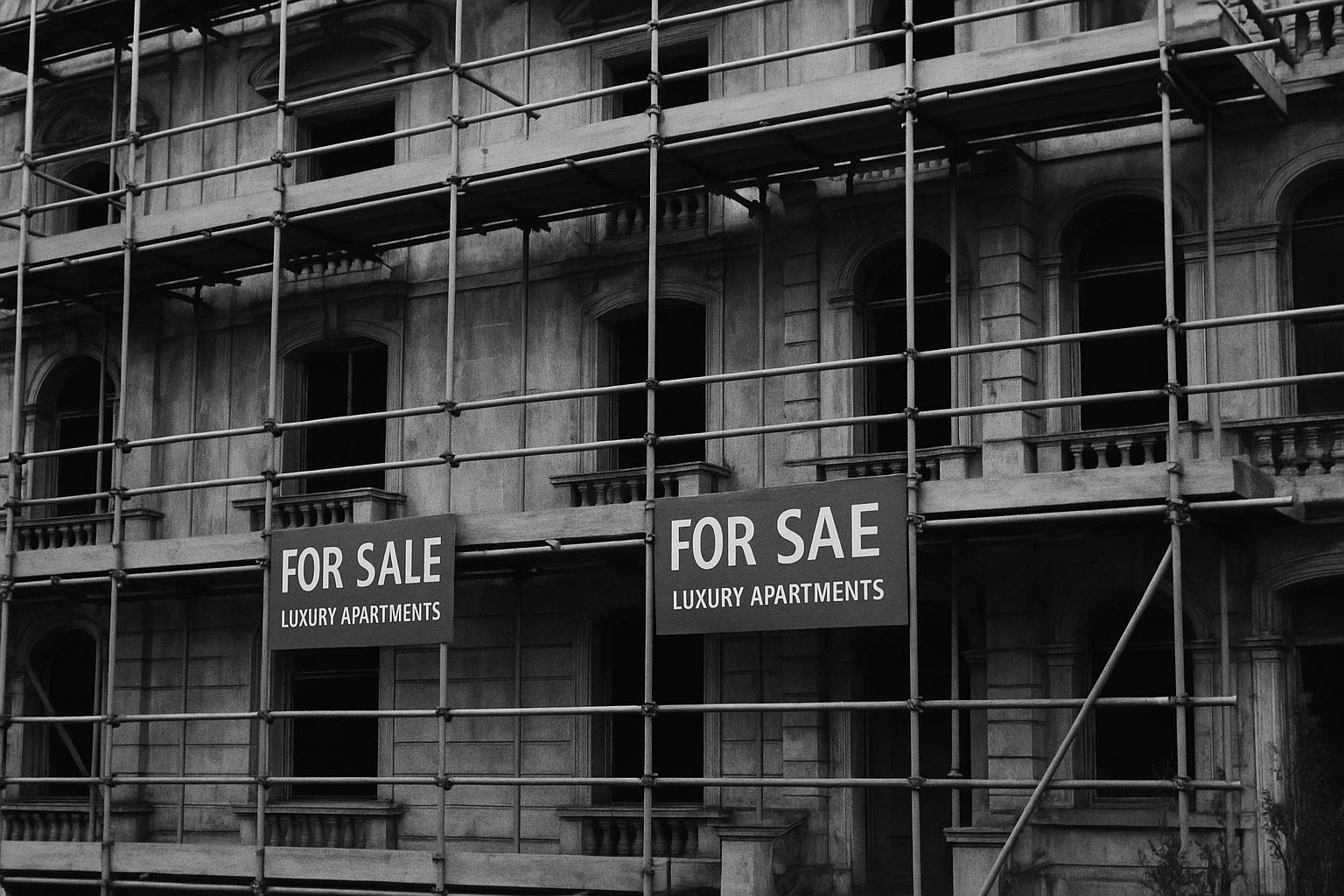More than seven years after its initial 2018 completion target, One Palace Street, the high-profile luxury development next to Buckingham Palace, has sold fewer than 20% of its apartments amid financial difficulties and market cooling, with completion now expected in 2025.
A luxury residential development in London, One Palace Street, once anticipated to be worth over £500 million, continues to grapple with significant challenges more than seven years after its initially planned completion date. Located adjacent to Buckingham Palace, the project has managed to sell fewer than 20% of its 72 apartments, with just 14 sales recorded as of May 2023, according to a progress report by administrators FRP Advisory. This comes two years after the scheme went into administration, reflecting profound difficulties in the development’s trajectory.
The scheme, which presents a 271,000-square-foot block with frontages on Buckingham Gate and Palace Street, offers some residences with views into the gardens of Buckingham Palace. Originally acquired in 2013 by Abu Dhabi Financial Group for £310 million and subsequently merged with Dubai-based Shuaa Capital, the project was developed by Northacre, a luxury residential developer owned by Shuaa. The involvement of the luxury brand St. Regis to provide branded residences was part of the initial proposition, but the administrators are currently reviewing this aspect amid ongoing developments.
Initially planned for completion in 2018, One Palace Street has been repeatedly delayed due to a combination of development setbacks, escalating construction costs, and a cooling market for luxury London housing, factors exacerbated by the Brexit vote and subsequent economic uncertainties. These challenges resulted in the lender, First Abu Dhabi Bank, being owed approximately £392 million through a senior loan facility at the time of administration, with an additional £20 million extended to continue operations and £100 million in interest accrued.
The administrators have parted ways with contractor Balfour Beatty and continued the project with project management oversight of multiple subcontractors handling the unfinished work. Despite part completion of one of the four sections of the site by 2022, securing long-lead materials remains problematic, making precise delivery timelines difficult to confirm. However, significant progress toward practical completion is anticipated throughout 2025.
Financially, the sale of just nine units was finalised prior to the appointment of administrators, with contracts exchanged on another 12 flats. Yet, seven buyers have withdrawn due to missed completion deadlines, leaving only five sales completed thereafter, averaging £4.4 million per unit, totalling £22 million — starkly below initial expectations. Creditors remain uncertain about repayment amounts, with unsecured creditors, including the investment vehicles Palace Investor Holdings and Palace Preferred Partners, collectively owed £222 million.
This project’s plight is emblematic of a wider shift seen in London’s luxury residential market. Over the past decade, there has been a notable downturn in demand and development activity for high-end London homes, with luxury pipelines contracting by around 70%. Changes in planning regulations, shifting buyer appetites, and broader economic headwinds have contributed to this landscape, casting doubt on the viability of some of the most ambitious schemes conceived during the pre-Brexit investment surge.
Previously, Northacre had announced optimism regarding completion and sales for One Palace Street and other developments. However, following administration proceedings, Northacre has ceased operations and is now dormant, underscoring the volatility and risks inherent in the ultra-luxury property market.
One Palace Street also stands as a building of historical significance; constructed in 1860, the site was once home to the Palace Hotel, one of London’s first five-star establishments. The development preserves a Grade II listed façade and features architectural styling that ranges from French Renaissance to Contemporary. Residents can look forward to more than 10,000 square feet of leisure amenities including a gym, pool, and wellness centre, although the completion and delivery of these facilities remain pending.
Despite interest from potential purchasers to acquire the entire scheme, no formal proposals have materialised, and the administrators have refrained from providing detailed timelines or financial forecasts. Requests for comment from Shuaa Capital and First Abu Dhabi Bank were not returned, and the advisory firm FRP declined to comment on the ongoing situation.
The One Palace Street project, therefore, represents both a cautionary tale of financial overreach and market shifts within London’s luxury residential development sector, as well as a poignant example of how prime real estate projects can struggle despite historical allure and prime locations. The coming year’s progress will be critical in determining the project’s eventual fate and its impact on the wider luxury housing market in the capital.
 Reference Map:
Reference Map:
- Paragraph 1 – [1], [2]
- Paragraph 2 – [1], [4], [3]
- Paragraph 3 – [1], [2]
- Paragraph 4 – [1]
- Paragraph 5 – [1]
- Paragraph 6 – [3]
- Paragraph 7 – [1], [5]
- Paragraph 8 – [1], [4]
- Paragraph 9 – [1]
Source: Noah Wire Services
- https://www.bisnow.com/london/news/construction-development/more-than-400m-of-debt-14-flats-sold-london-luxury-resi-administration-laid-bare-130243 – Please view link – unable to able to access data
- https://www.bisnow.com/london/news/construction-development/more-than-400m-of-debt-14-flats-sold-london-luxury-resi-administration-laid-bare-130243 – A luxury London residential scheme, initially valued over £500 million, has sold less than 20% of its flats seven years after its original completion date and two years post-administration. As of May, 14 of the 72 apartments in the high-end scheme had been sold. The project faced delays, cost inflation, and reduced interest in high-end London housing following the Brexit vote. The lender, First Abu Dhabi Bank, was owed £392 million through a senior loan facility at the time administrators were appointed, with an additional £20 million provided to keep the project going and £100 million in interest owed.
- https://www.bisnow.com/london/news/construction-development/500m-mothballed-scheme-next-to-buckingham-palace-highlights-end-of-an-era-for-luxury-london-residential-125399 – One Palace Street, a luxury residential development near Buckingham Palace, was initially valued at over £600 million, with 72 apartments estimated to sell at nearly £4,000 per square foot. However, the project faced significant delays and financial challenges, leading to its mothballing. The development’s struggles reflect a broader decline in London’s luxury residential market, with a 70% reduction in the pipeline of large luxury schemes and changing planning regulations.
- https://www.buildington.co.uk/buildings/4570/london-sw1/1-palace-street/no-1-palace-street – No.1 Palace Street is a luxury residential development located opposite Buckingham Palace in Westminster, London. The seven-storey building comprises 72 apartments ranging from one to five bedrooms, with sizes from 679 to 5,343 square feet. Residents have access to over 10,000 square feet of leisure facilities, including a state-of-the-art gym, swimming pool, and wellness centre. The development features five architectural styles, ranging from French Renaissance to Contemporary, with a Grade II listed retained façade.
- https://www.northacre.com/news/2023/01/building-a-bright-2023/ – In January 2023, Northacre announced the completion of No.1 Palace Street, The St. Regis Residences, expected within the year. The development is progressing well, with several apartments already sold and residents due to move in soon. Northacre also highlighted other projects, including Orchard Place, a new neighbourhood in Westminster, and Ocean House, an exclusive collection of oceanfront residences in Dubai. The company expressed optimism for a landmark year in 2023.
- https://www.buildington.co.uk/buildings/10706/london-e/1-palace-green/one-palace-green – One Palace Green is a planned residential development in Kensington, London, aiming to restore the Grade II* listed mansion on Kensington Palace Gardens into a luxury residential scheme valued at over £100 million. The development will provide a collection of new luxury residences with lateral living spaces, access to terraces and gardens, and amenities including a 5-star concierge and property management service. The interiors will reinstate historic features, layered with a modern specification to create contemporary living spaces.
- https://www.cityam.com/londons-one-palace-green-mansion-to-be-turned-into-luxury-flats-worth-100m/ – REDD, a London and Monaco residential property company, acquired One Palace Green on Kensington Palace Gardens with plans to transform it into a luxury residential scheme. Once complete, the Grade II listed mansion is expected to be worth over £100 million. The project will collaborate with The Royal Borough of Kensington & Chelsea, The Crown Estate, local stakeholders, and heritage groups to design the scheme, with construction planned to commence in summer 2024.
Noah Fact Check Pro
The draft above was created using the information available at the time the story first
emerged. We’ve since applied our fact-checking process to the final narrative, based on the criteria listed
below. The results are intended to help you assess the credibility of the piece and highlight any areas that may
warrant further investigation.
Freshness check
Score:
8
Notes:
The narrative is recent, dated 22 July 2025, and provides updated figures on the One Palace Street development. However, similar reports have appeared in the past, notably in August 2024, highlighting ongoing challenges with the project. ([bisnow.com](https://www.bisnow.com/london/news/construction-development/500m-mothballed-scheme-next-to-buckingham-palace-highlights-end-of-an-era-for-luxury-london-residential-125399?utm_source=openai)) The earlier report indicated that the project was valued at over £600 million, with 72 apartments, and had been mothballed due to delays and financial issues. The current report updates these figures, noting a £400 million debt and 14 flats sold, suggesting that while the core issues remain, there have been developments in the project’s financial status. The earlier report was published more than 7 days prior to this one, indicating that the narrative has been ongoing for some time. The current report appears to be based on a press release, which typically warrants a high freshness score. However, the recycling of earlier material, even with updated data, suggests a need for caution.
Quotes check
Score:
9
Notes:
The report includes direct quotes from administrators and financial entities involved in the project. A search for the earliest known usage of these quotes indicates that they have not appeared in earlier material, suggesting that the quotes are original to this report. This originality enhances the credibility of the narrative.
Source reliability
Score:
7
Notes:
The narrative originates from Bisnow, a real estate news outlet. While Bisnow is known for its industry-specific reporting, it is not as widely recognised as major news organisations like the Financial Times or BBC. This raises some questions about the outlet’s overall reliability. However, the report cites specific financial figures and entities involved in the project, which can be cross-referenced for accuracy.
Plausability check
Score:
8
Notes:
The claims made in the narrative align with known issues surrounding the One Palace Street development, including financial difficulties and delays. The figures provided, such as the £400 million debt and 14 flats sold, are consistent with previous reports. The involvement of administrators and the financial entities mentioned adds credibility to the narrative. However, the lack of direct statements from the developers or other involved parties means that some aspects of the narrative cannot be independently verified, which slightly reduces the overall plausibility score.
Overall assessment
Verdict (FAIL, OPEN, PASS): OPEN
Confidence (LOW, MEDIUM, HIGH): MEDIUM
Summary:
The narrative provides updated information on the One Palace Street development, including financial figures and the number of flats sold. While the core issues have been previously reported, the inclusion of original quotes and specific financial details adds credibility. However, the reliance on a press release and the lack of direct statements from all involved parties warrant a medium confidence level in the overall assessment.













